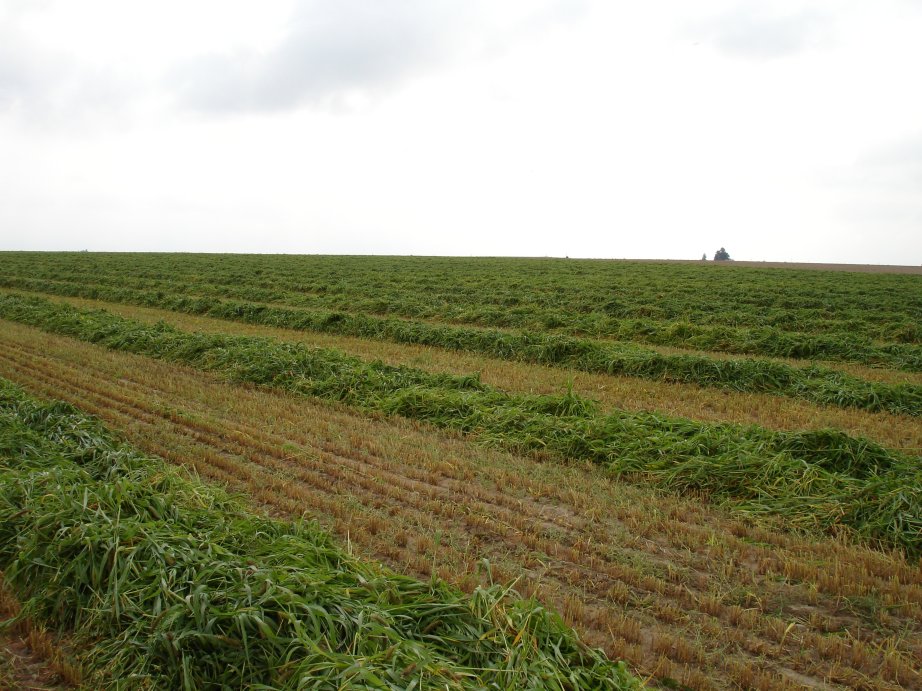
By Aaron Berger, Nebraska Extension Educator
Forage values in Nebraska for growing season grazing have seen significant increases over the last several years. Demand for grains encouraged many producers to convert tillable pasture land to crop land. In addition strong cattle prices have strengthened demand for summer grazing. Currently, crop prices have moderated while demand for summer forage has increased. This has created a scenario where many producers are considering planting annual forages on irrigated or dry land crop ground as a way to meet this forage demand.
To put the value of grazed forage at current prices in perspective, consider the following comparison of the cost per pound of air dried forage grazed by a cow-calf pair and its equivalent value on a per ton basis (Table 1 http://go.unl.edu/es9o). This example assumes a cow-calf pair is eating on average the equivalent of approximately 1200 pounds of air dried forage per month over a 5 month grazing season. Usually one would think that summer grazed pasture forage would be of higher quality than hay. However, this may not always hold true, especially as grazed forages mature in mid to late summer or drought conditions occur.
Windrow or swath grazing annual forages in the spring and summer offers two potential advantages over direct grazing. The first advantage is that the forage can be harvested at its optimum stage of quality and quantity based on the nutrient needs of the cattle that will be utilizing it. For growing cattle, forage can be harvested at a more immature stage resulting in greater forage quality. For cow-calf pairs or dry cows, the forage could be allowed to grow to a greater degree of maturity before swathing, thus producing more pounds of forage per acre. Figure 1 (http://go.unl.edu/seqq) shows the relationship between forage quality and yield as affected by the stage of plant maturity.
The second advantage of windrow grazing is the opportunity to significantly improve harvest efficiency. Typically it is estimated that 30-50% of annual forage that is grown and directly grazed actually gets consumed by the animal. The amounts may even be less for rapidly growing, tall summer annuals like sorghum-sudan hybrids. When an annual forage crop is windrowed at its optimum stage of maturity, these windrows can then be strip grazed and harvest utilization improved to 80-90% with daily temporary fence moves. The combination of windrowing forage at its optimum stage of maturity along with strip grazing can significantly increase the grazing days or pounds of forage per acre consumed by the grazing animals. For some producers, windrow grazing has worked successfully in situations where they already had adequate hay produced. The excess annual forage was windrowed and grazed directly, allowing them to lessen grazing pressure on perennial pastures.
The following are some management practices that can be important to success for windrow grazing annual forages during the growing season.
1. Develop a forage “chain” so the forages you want to windrow graze are not all at their optimum stage of maturity at the same time. Utilizing a combination of spring and summer planted annuals along with different planting dates can help stage these forages to match livestock forage demand.
2. In the late spring and early summer, only windrowing what cattle can eat in the next one to two weeks can help to keep windrowed forage from deteriorating should wet conditions occur. In the late summer and early fall, especially in central and western Nebraska, forage can be windrowed and quality better maintained as weather conditions are typically drier.
3. Have a pasture or sacrifice area where cattle can be fed for a few days if wet conditions would result in field damage from grazing.
4. Daily fence moves can greatly improve harvest efficiency over giving cattle several days of feed. Temporary electric fence along with electric fence mounted on center pivots that are then moved to ration out feed have been used successfully to strip graze.
5. Plant to test annual forages for nitrates before utilizing for windrow grazing. When cattle are direct grazing, they are typically grazing the tops of the plants and the leaves where nitrate concentrations tend to be lowest. With windrow grazing, cattle are eating the whole plant and nitrates which are usually most concentrated in the bottom third of the plant will be consumed. A variety of factors can influence nitrate levels in annual forages. Test plants prior to windrowing to identify at what level nitrates are.
Windrow grazing is usually thought of as a management tool to utilize for fall and winter grazing. However, windrow grazing annual forages in the spring and summer can provide a way to harvest forage at its optimum for quality and quantity while efficiently utilizing the feed produced. The NebGuide Windrow Grazing (http://go.unl.edu/nz4n ) provides additional information on the topic. A video titled Windrow Grazing in Nebraska (http://go.unl.edu/krhg ) also provides further information and examples. For more information on growing annual forages see the NebGuides Summer Annual Forages for Beef Cattle in Western Nebraska (http://go.unl.edu/et5y), Utilizing Annual Forages for Beef Cattle During and Following Drought (http://go.unl.edu/w3ew), and Summer Annual Forage Grasses (http://go.unl.edu/3pxs).